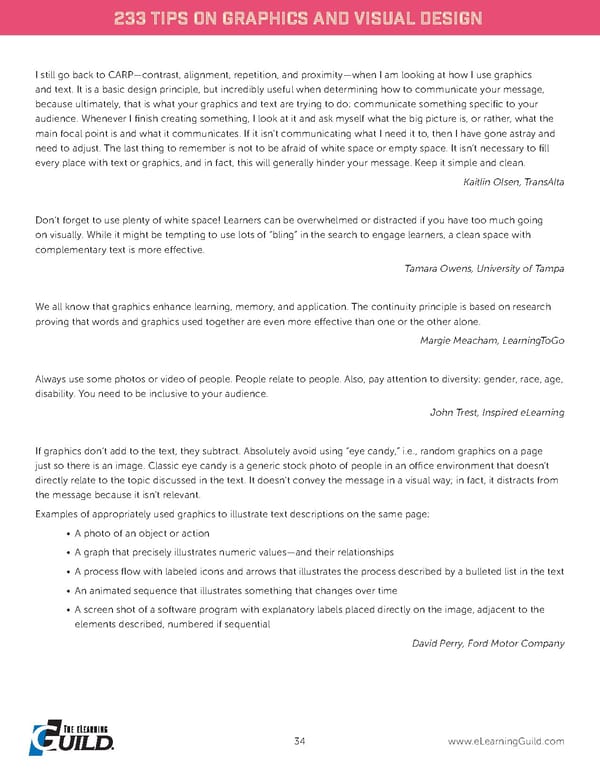233 TIPS ON GRAPHICS AND VISUAL DESIGN I still go back to CARP—contrast, alignment, repetition, and proximity—when I am looking at how I use graphics and text. It is a basic design principle, but incredibly useful when determining how to communicate your message, because ultimately, that is what your graphics and text are trying to do: communicate something specific to your audience. Whenever I finish creating something, I look at it and ask myself what the big picture is, or rather, what the main focal point is and what it communicates. If it isn’t communicating what I need it to, then I have gone astray and need to adjust. The last thing to remember is not to be afraid of white space or empty space. It isn’t necessary to fill every place with text or graphics, and in fact, this will generally hinder your message. Keep it simple and clean. Kaitlin Olsen, TransAlta Don’t forget to use plenty of white space! Learners can be overwhelmed or distracted if you have too much going on visually. While it might be tempting to use lots of “bling” in the search to engage learners, a clean space with complementary text is more effective. Tamara Owens, University of Tampa We all know that graphics enhance learning, memory, and application. The continuity principle is based on research proving that words and graphics used together are even more effective than one or the other alone. Margie Meacham, LearningToGo Always use some photos or video of people. People relate to people. Also, pay attention to diversity: gender, race, age, disability. You need to be inclusive to your audience. John Trest, Inspired eLearning If graphics don’t add to the text, they subtract. Absolutely avoid using “eye candy,” i.e., random graphics on a page just so there is an image. Classic eye candy is a generic stock photo of people in an office environment that doesn’t directly relate to the topic discussed in the text. It doesn’t convey the message in a visual way; in fact, it distracts from the message because it isn’t relevant. Examples of appropriately used graphics to illustrate text descriptions on the same page: • A photo of an object or action • A graph that precisely illustrates numeric values—and their relationships • A process flow with labeled icons and arrows that illustrates the process described by a bulleted list in the text • An animated sequence that illustrates something that changes over time • A screen shot of a software program with explanatory labels placed directly on the image, adjacent to the elements described, numbered if sequential David Perry, Ford Motor Company 34 www.eLearningGuild.com
 233 Tips on Graphics and Visual Design Page 36 Page 38
233 Tips on Graphics and Visual Design Page 36 Page 38